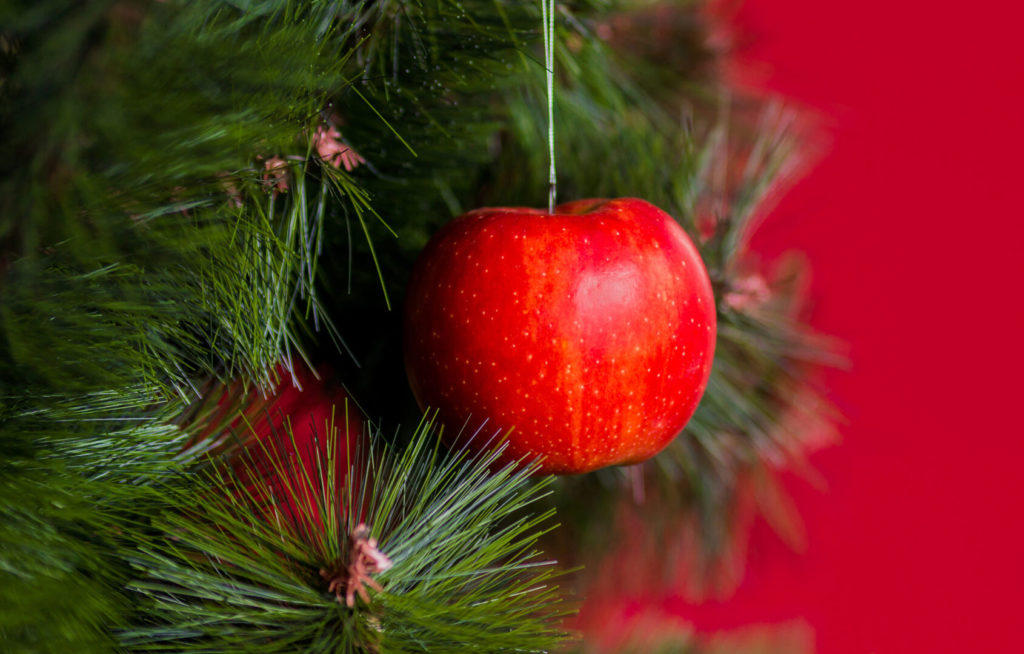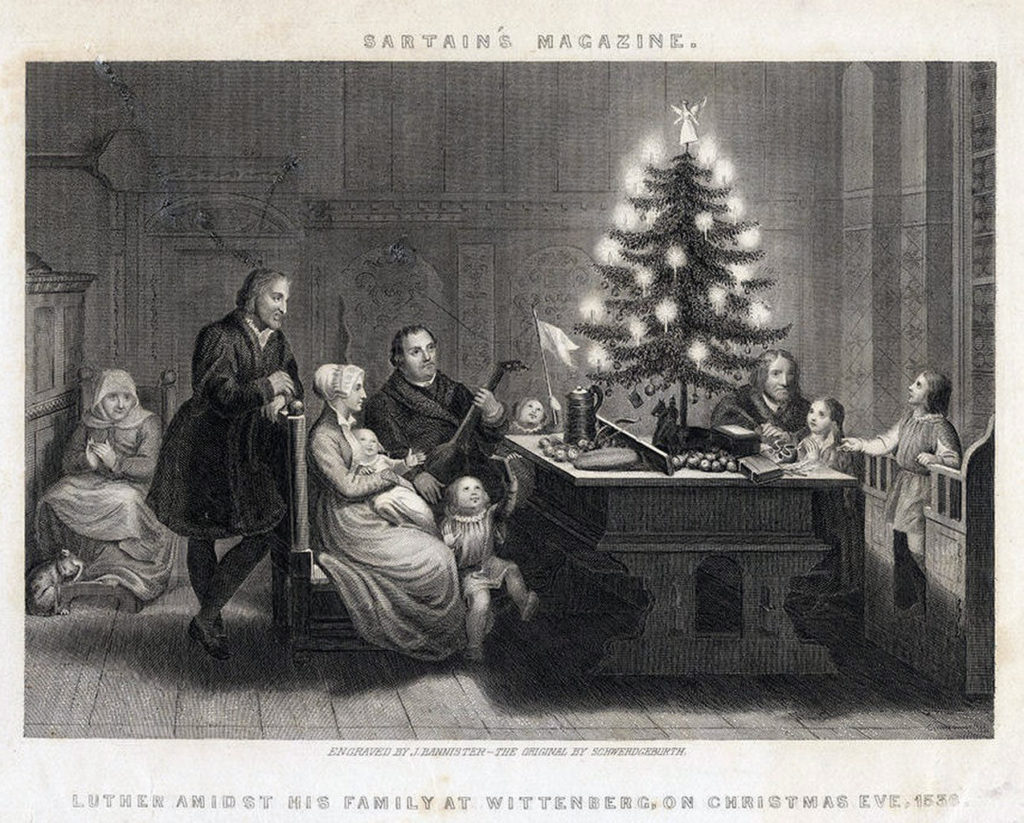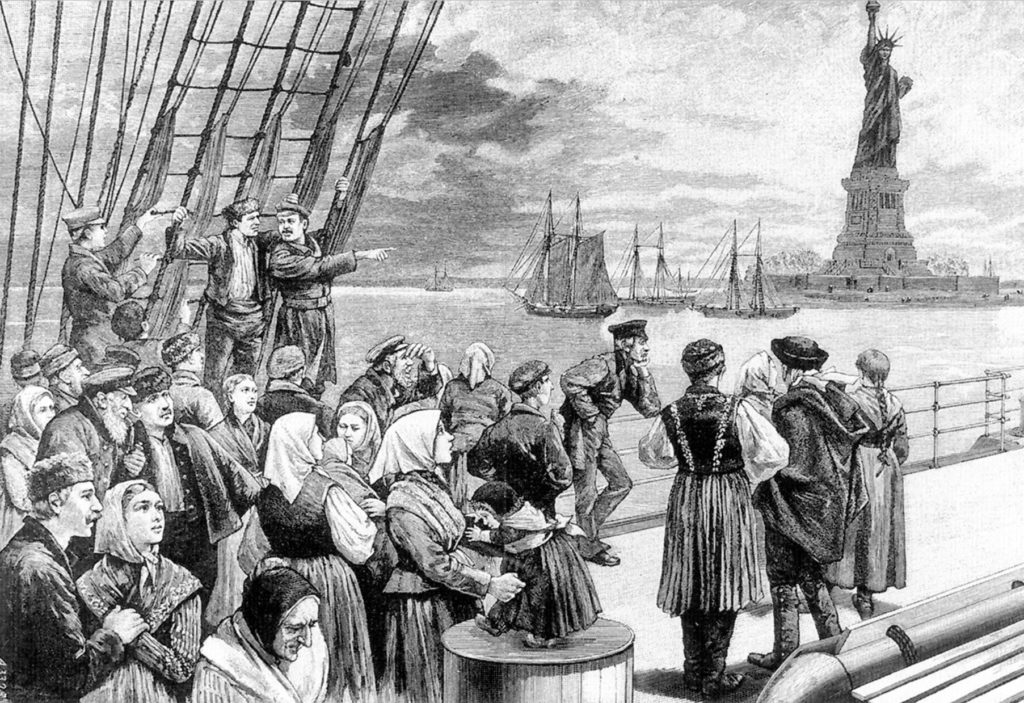The Facinating History of the Christmas Tree

Part One
Why are trees a part of Christmas celebrations?
Where did this tradition come from?
Well, you may have heard some say that Christmas trees are just a pagan symbol that Christians stole from other religions.
Though this idea is popular, it’s not actually based on much historical evidence.
The closest we have to anything like that is an old story about St Boniface – an English missionary who traveled to Germany to tell people about Jesus around the year 730AD.

The story goes that he came across some native Germans who were going to sacrifice a child to the god Thor in front of a large oak tree. To save the child, St Boniface chopped down the tree to the amazement of the Thor-worshippers, who had expected Boniface to be struck down by lightning.
In later accounts of the story, after the tree is chopped down, St Bonface noticed a small fir tree growing nearby. It was around Christmas time and so Boniface told the Germans:
“This little tree, a young child of the forest, shall be your holy tree tonight. It is the wood of peace, for your houses are built of the fir. It is the sign of an endless life, for its leaves are evergreen. See how it points upward to heaven. Let this be called the tree of the Christ-child; gather about it, not in the wild wood, but in your own homes; there it will shelter no deeds of blood, but loving gifts and rites of kindness.”
Now, we don’t know for sure if this later bit actually happened. But what we do know is trees were being used as a Christian symbol hundreds of years before St Bonface went to Germany.
Most likely the origin of Christmas trees goes way back to Medieval Times in the 5th century.
In an era when most people couldn’t read the bible for themselves, churches put on “Mystery” or “Paradise” Plays, in order to teach the people bible stories. December 24 had been assigned as the feast day of Adam and Eve in preparation for Christmas Day. The idea was that the sin of Adam & Eve was remembered before we remember the birth of the Messiah.
In the lead up to Christmas, the Medieval Church used to put on plays telling the whole story from the Garden of Eden to the coming of Christ. One of the main features of this play was what they called a “Paradise Tree”. It was an evergreen tree that they hung red apples and white wafers on. The red apples represented the forbidden fruit and the white wafers represented Christ.

Believe it or not, this is actually where the tradition of hanging red baubles and other ornaments on the Christmas Tree came from. Over time, the idea of using a decorated evergreen tree to remember and celebrate the birth of Christ became a tradition not only for church plays, but also for Christians individually.
Lots of other religions have used trees and branches as part of the worship of their gods. But that doesn’t make trees themselves a pagan symbol. God’s people have had trees as part of their religious narrative from the very beginning – from the tree of knowledge of good and evil, to the olive leaf telling Noah the Flood was over. Think of Moses and the burning bush, and the branches used in the Feast of Booths or to praise Jesus on Palm Sunday. The cross Jesus died on is even described as a tree, and in the last book of the Bible, the sign that the curse of death is gone is the return of the tree of life, whose leaves are for the healing of the nations.

Part Two
Trying to tie down the history of the Christmas Tree to one thread is not easy. Two countries in Europe claim to be the first to host a Christmas Tree in their public square. Latvia claims it was in one of their cities in 1510, and Estonia claims they did it earlier in 1444.
But how did Christmas trees become a decoration that people would have in their own home?
Well, that tradition is attributed to the Christian reformer and German preacher, Martin Luther.
In 1536, one winter’s night before Christmas, Luther was walking through a pine forest near his house. He looked up and saw the beautiful stars twinkling through the tree branches. He was so moved, he went home and told his children that it reminded him of Jesus, who left the stars of heaven to come to earth at Christmas. Luther went, chopped down a smaller pine tree, brought it into his house and decorated it with candles to represent the stars. This is said to be the first time that lights were used to decorate a Christmas tree.

The story goes that Luther led his family in singing a hymn that he had written in 1531. These are the first two verses of that hymn:
Good news from Heav’n the angels bring,
Glad tidings to the earth they sing:
To us this day a Child is giv’n,
To crown us with the joy of Heav’n.
This is the Christ, our God and Lord,
Who in all need shall aid afford;
He will Himself our Saviour be,
From all our sins to set us free.

Now, we don’t know how this story about Martin Luther was spread, but from that point on we have evidence of Christmas trees growing in popularity, particularly in Germany.
The first official record of a Christmas tree being used is found in German Lutheran documents from the 16th century that state that in 1539 a Christmas tree was placed in the Cathedral of Strasbourg.
The earliest depiction of a Christmas tree is dated to 1576 and found in a keystone sculpture in an archway in early Germany.
By the early 1600s, decorated Christmas trees were a common tradition in Southern Germany, as one German writer reported in 1605:
“At Christmas they set up fir trees in the parlours of Strasbourg and hang thereon roses cut out of many-coloured paper, apples, wafers, gold foil, sweets, etc.”
But how in the last 400 years did Christmas trees spread from Germany to become such a staple part of Christmas traditions across the world?
Part Three
By the 1800s, the tradition of Christmas trees has taken hold across all of Germany and was seen to be an expression of German culture. As Germans travelled the world they took this tradition with them, but it took a while to for it to be embraced by other countries.

German immigrants brought it to the US, but it was generally seen as a bit of a weird European practise. Because of this, the rumour developed that Christmas trees were a pagan idea, despite the fact that Christians had instigated and developed the tradition from the very beginning.
In fact, over the centuries, Christmas itself was frowned upon by many Protestants both in England and America, with Christmas celebrations being made illegal at different times in history.
It was the influence of the English Royal family that ultimately changed the attitude to Christmas and Christmas trees across the globe. On the 10th of February 1840, Queen Victoria married her German cousin, Prince Albert and with that, the German love of Christmas traditions came into the English monarchy. In 1841, Prince Albert had a Christmas tree set up at Windsor Castle and the public opinion of Christmas trees in England very quickly began to change.
Every year, Queen Victoria advertised their Christmas celebrations and these were illustrated and shared across, not only the British Empire, but also America. The English Royals were the trend-setting celebrity influencers of the 1800s and their customs, clothing styles and yes, holiday traditions shaped the fashion of the West.
Possibly the most significant month in the history of the Christmas tree, was December 1848, when the Illustrated London News published a drawing entitled “Christmas Tree at Windsor Castle”.

It portrayed the Royal couple with their children standing around a tree decorated with candles and ornaments and topped with an angel. This illustration went the 1800s equivalent of “viral” and with that, Christmas trees turned from being seen as some weird little German decoration, to the epitome of high fashion across the Western world.
The popularity of Christmas trees continued over the next two centuries, with the invention of electric lights, plastic decorations and artificial trees in the 1900s. Slowly, the Christmas tree, like Christmas itself, has become more and more commercialised and fake. Those old rumours of Christmas trees being just a pagan rip-off have resurfaced, and the Christian origins of the Christmas tree have been forgotten by many.
We no longer look at the red baubles and think of the fruit on the tree of knowledge of good and evil.
We don’t see the twinkling lights and reflect like Martin Luther, on the stars of the heavens.
But one tradition has stayed. Most people, whether Christian or not, still put either an angel or a star at the top of their Christmas tree – pointing to the angels who declared the birth of Jesus and the star that led the wise men to the Messiah that they were seeking.

The Christmas tree has had a very interesting history. If you have one set up at home, I hope you can remember these words from the story of St Boniface:
“It is the sign of an endless life, for its leaves are evergreen. See how it points upward to heaven. Let this be called the tree of the Christ-child; gather about it, not in the wild wood, but in your own homes; there it will shelter no deeds of blood, but loving gifts and rites of kindness.”
(608)
